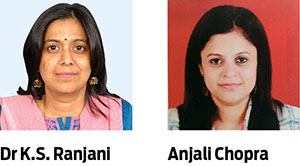Findings of a study among microenterprises to assess their readiness to accept digital payment solutions
“Millennials don’t want to dig their wallets. They are absolutely comfortable paying via smart phones whether it is coffee or buying a sweatshirt”– Yuliia Mamonaova, Blogger
By Dr K.S. Ranjani and Anjali Chopra
Imagine stopping for coconut  water by a small roadside shop. After consuming the coconut water, you realise that you have forgotten to carry your wallet. Luckily for you, the vendor accepts PayTM. That comes as a relief! Today rickshaw drivers, roadside vendors and tiny, informal enterprises accept digital payment, making life easier for most of us. In fact, the younger age group comprising the millennials and the gen next, prefer to settle transactions digitally.
water by a small roadside shop. After consuming the coconut water, you realise that you have forgotten to carry your wallet. Luckily for you, the vendor accepts PayTM. That comes as a relief! Today rickshaw drivers, roadside vendors and tiny, informal enterprises accept digital payment, making life easier for most of us. In fact, the younger age group comprising the millennials and the gen next, prefer to settle transactions digitally.
A study done by VISA in 2018 suggests that millennials prefer to make payments through mobile devices using applications like Apple and Android Pay. In fact, 65% of millennials have paid for certain products or services via mobile compared to 42% of the general population. It is estimated that Indian digital payments industry will touch $500 billion by 2020, contributing 15 per cent to the country’s GDP. As the reach of digital technology widens and deepens, small value transactions are not likely to be cash driven either. This is reiterated in a 2016 BCG-Google report, which states that India’s digital payment story would receive impetus by micro transactions which currently account for approximately half of person-to-merchant transactions (micro transactions are transactions with value lower than Rs100 equivalent to roughly $1.4).
A huge question therefore remains: Is the micro enterprise eco system digital ready? Can we see micro businesses such as vegetable vendors, fruit shops, mobile repair shops hustling by the road side and are mostly manned by a single person, becoming digital savvy and accepting most of the payment digitally? Not just small brick and mortar enterprises, but also service providers such as carpenters, plumbers and electricians who can give better customer experience by accepting digital cash? When micro enterprises are unable to migrate to digital platform solutions, there are high chances that they may lose out the opportunity to get empaneled on aggregator sites like food delivery, household essential services etc. thereby missing out a wider customer base.
We undertook a study among microenterprises to assess their readiness to accept technology driven solutions in their business, chiefly digital payment solutions. The survey was conducted among microenterprises such as vegetable stalls, fruit vendors, small eateries and similar micro businesses based in Mumbai suburbs. We sought to measure the extent of adoption of digital payment by target respondents and found that of those that had adopted digital payment, close to 65% reported that less than 25% of their transactions were digital while the remaining 75% transactions were in cash. Only 2% of the respondents had more than 50% of their transactions through digital payment.
We analysed the responses to understand the key drivers of digital adoption solutions in micro enterprises. Ease of using digital solutions (navigation, simplicity in understanding, ability to use solutions for store purchase etc.), network influence (peer recommendation, customer demand, influence of family members) and transaction cost (cost of operations reducing in the long run, perception of it being cheaper in the long run) were the significant drivers. Further ease of use was the single most important determinant of digital adoption followed by network influence and then perception of lower transaction costs. We theorised that perceived risk (fear of fraud, cash is easier to tally end of day etc.) would be a significant impediment to digital adoption. However the findings were somewhat counter intuitive in that, micro enterprises did not perceive digital solutions as risky. Rather their reluctance to adopt digital solutions was more to do with their lack of understanding on how to use it, or lack of endorsement from their network who did not champion its use.
Technology solutions usually improve user experience by adding new features. However, considering that 83% of our respondents did not have access to college education and 17% of our respondents did not complete school education, our respondents did not look for features, but rather wanted a solution that was easy to understand and deploy. Most microenterprises had a manpower crunch (94% surveyed had fewer than 5 employees), and hence time was a constraint. They had little time to explore and learn a new technology, and therefore their requirement is to operate digital solutions which are functional and easy to use.
What does this study hold for digital solution providers? A significant revelation of our study has been that the marginalized section of the society is ready to use technology provided it has demonstrable cost saving implications and is easy to use. We believe that rather than focusing on fancy features, digital solution providers should emphasise how both time and money is saved by not commuting to bank branches for deposit and withdrawal of cash. Over time digital solutions can provide simple tips on saving money for illness, marriage, education etc. So ease of use is a critical driver of adoption. Further, the study also reveals that such technologies will not only be used but are also likely to be recommended to peers and the quantum of usage is likely to increase, if suitably marketed to the target segment. Micro enterprises operate in dense clusters in the same neighbourhood, often times helping each other out in their day to day business operations. It has been observed that typically in a cluster, one or two enterprises become anointed as influencers and opinion leaders due to their profitable business or being preferred by customers, and if these influencers became early adopters, it had a cascading effect.
Extensive work on the role of network community or what is called subjective norm has revealed that respondent profile, type of technology, type of enterprise (small, medium, large) etc. could have an effect on rate of adoption of digital solutions. Prior studies have shown that role of the community is limited; however this was true for large enterprises, and also true in cases of developed economies. Our study points out that network community is a significant driver of digital solution adoption which is not surprising given that bottom of the pyramid people work together in large groups, often times sharing resources. Sometimes entire communities migrate to new cities to set up businesses, because one enterprising person from the community spotted an opportunity. This dependency on their own community points to the fact that role of peers, and the community is extremely important in driving adoption of digital solutions. In instances where the authors find high adoption of digital solution, it was revealed that younger members of the enterprise decided to migrate or a senior member whose business started flourishing after going digital, recommended payment applications or mobile banking in their community.
Is the study going to benefit the society? We believe that it addresses an important need for the target segment by helping them transition into financial services by access to digital solutions. Consider the case of Shyam Yadav (name changed), who sells sandwiches and coffee inside a college premises. He believes that with the advent of digital solutions, his customers have started paying him promptly and do not ask for credit. He is also able to receive money into his bank account directly. This is significant because this “digital footprint” now makes Yadav a potential borrower. The bank gets a trail of his transactions and will be able to do a credit assessment and help him with loans, should he require them. It also helps him transition to other financial services such as insurance.
As Yadav increases his transactions and gets comfortable using digital solutions, he will shift from discomfort construct to optimistic construct on the technology readiness construct. As he becomes optimistic, he will become open to newer technologies indicating a shift in his mental make-up. A whole new world of opportunities will now open up before him and now Yadav realises that the smartphone that he has, can not only be used for WhatsApp and social media but also can actually make him financially savvy.






















